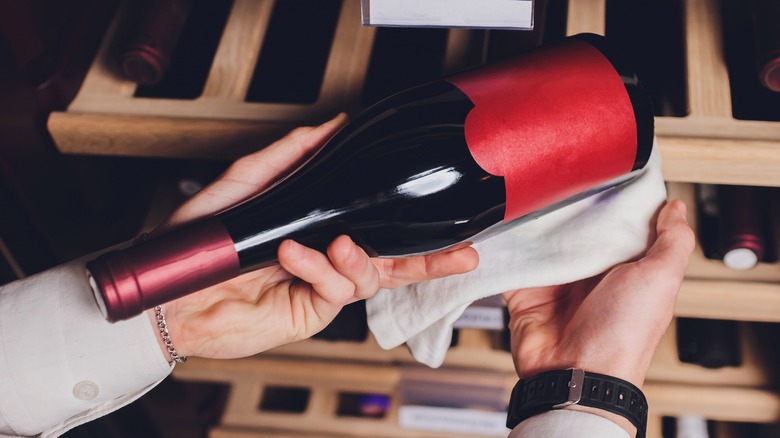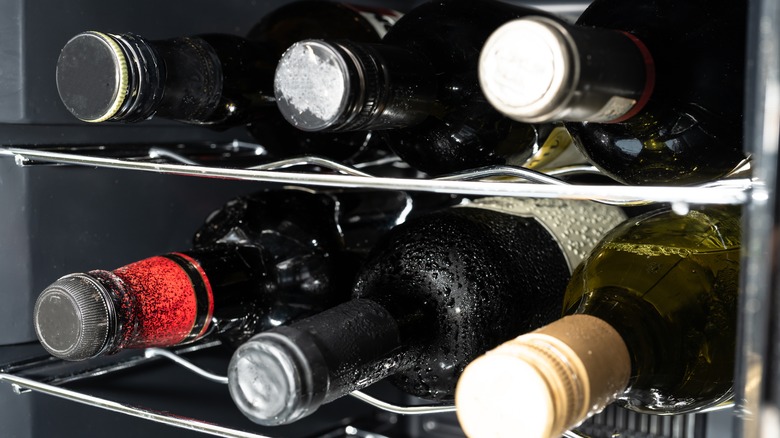Expert Tips On Chilling Red Wine
There's a common misconception that red wine should always be served at room temperature, but that's not necessarily the case. According to Gabriel Corbett, sommelier of the two Michelin-starred restaurant JÔNT, chilling reds accents the symphony of flavors that compose them. That's because when red wine is served above 66 degrees, the structure of the alcohol, acid, and various flavors becomes unbalanced. It can taste bitter, and the alcohol will have a more forward presence on the palate. All reds benefit from being chilled below 66 degrees, but there are more specific ideal temperature ranges for them depending on the varietal.
Plus, the term "room temperature" is a bit misleading. What room is being referred to — a pleasant three-season room in the middle of autumn or a dusty garage sweltering in the height of the summer heat? A wine cellar is also a room, and at JÔNT, Corbett keeps his reds in a typical cellar climate between 55 and 56 degrees Fahrenheit. There's nothing wrong with enjoying red wine at room temperature if that's what you prefer, but considering what Corbett has to say about drinking it chilled, you may want to break outside your comfort zone and give it a try.
The ideal temperature changes with the type of wine
While you should be chilling all red wine for the best flavor experience, not all varieties should be cooled to the same temperature. Corbett notes that "lighter bodied red wines — lower in alcohol and tannins but elevated acid — can generally be served at a lower temperature, but it also depends on how a guest likes their wine." These often cheaper, immature varieties are great mixed up with Coca Cola for a Spanish Kalimotxo cocktail.
Pinot Noirs are an example of a medium-bodied red, which are at their best when chilled to 54 to 56 degrees Fahrenheit. A Tempranillo can be cooled a bit more — 56 to 60 degrees — as it is a medium to full-bodied variation. And full-bodied, high-in-alcohol varieties like a Shiraz can be served a touch warmer at 61 to 65 degrees.
Just as vino can be too warm to fully embrace all the harmonious flavors, refrigerating it makes it too cold to age properly. The amicable climate of a wine chiller is ideal for keeping a bottle in its perfect state but not everyone owns a chiller, and even fewer have a wine cellar in their home. Thankfully, there are some tricks you can implement to drink your inebriating beverage at its best quality.
Tips on cooling, storing, and ordering
While you'd love to store it at something close to serving temp, that's not always in the cards. Don't settle for warm vino for lack of planning. Popping it in the fridge for 30 minutes or less than a dozen in the freezer will reduce the temp, and if you use a bucket of ice to cool it, this rapid chilling hack works on wine, Champagne, or whatever you'd like to be enjoying.
The climate reds stay in before being opened weighs heavily on its quality, but perhaps equally important is not where it is stored but how. Corbett stressed the importance of keeping bottles horizontal before opening so the cork stays saturated, which cuts down on air making its way into the bottle. However, he does note that for storing an open bottle of red "it matters far less if the wine is stored horizontally or vertically."
And should you order a bottle that comes out warmer than you'd prefer, understand there is a proper etiquette for sending back a bottle of wine at a restaurant, and those managing wine service are there to ensure you have the best experience possible. As Corbett put it, "We always strive to make sure the guest gets what they want."


